If autism gives you a superpower, mine is watching Les Mis
The 50 Les Misérables adaptations I've watched/read/listened to, ranked, pie charted, and listicled
Today I finished my 50th adaptation of Les Misérables. I track them all on a spreadsheet busy enough that Excel lags whenever I try to edit it. So today I present you with an unnecessarily long look at all that data.
After some introductory rules and parameters, part 1 will give you some Spotify-wrapped-style pie charts and numbers about what it is I’ve actually watched, read, and listened to.
Part 2 will contain listicles ranking the adaptations in some very important categories, taking you through the best bobs, the best “To the barricades!”es, and the least cool (ie. the best) Mariuses.
Once I’ve familiarised you with the general landscape of these adaptations through parts 1 and 2, in part 3 I will rank my top 10.
We’ll then end with a drinking game / bingo card that you can use in your own Les Mis watching adventures, and then some of the adaptations I’m looking forward to getting to in the near future!!
Intro: the rules (and how I ended up here)
You can totally skip this section and not really miss out, but any good spreadsheet needs some rules, so here we are.
In terms of what counts as an adaptation, my definition is broad and arbitrary, but these are some key points:
Different productions of the musicals count as different adaptations. Is this cheating? Maybe. But I have enough opinions on each different production that they warrant their own row in the spreadsheet, and my spreadsheet = my rules.
An adaptation needs to be a stand-alone piece. This means the 1980 concept album counts, but different cast recordings do not count, because they are only part of a production.1
Parodies do count, as long as they’re parodying a decent chunk of the story. So parodies of a single song from the musical don’t count.
‘Loose’ adaptations, ie., those where the story is transposed into a totally new setting, do count.
To answer the question of how I came to be in the position of having consumed2 50 Les Mis adaptations, and having organised all of them in a spreadsheet, I offer another numbered list:
In March this year, I made the mistake of thinking I could prepare some uni essays about Hugo’s use of metalepsis, and that I could be super normal about it.
I was overcome with an urge to reread my favourite book ever, now with a newfound appreciation for its narrative technique.
I didn’t have time to reread a 1300-page book whilst I was meant to be revising for exams.
I thought I could overcome this urge by just watching the movie musical… and then the concert… and then the other concert…
I’m autistic.
Part 1: the graphs!!
Graph 1: Language
I’ve consumed Les Mis adaptations in a total of twelve languages. For this pie chart, I counted dubbed/translated works as their original language, and included silent films in their original language because they often have intertitles.
Graph 2: Genre
Of the 16 musicals, 15 were versions of the Schönberg and Boublil musical; and the other was Gavroche the musical (2020), a work performed entirely by children and featuring a tap break during the barricade-building.
Of the 14 full-length films, two were telefilms3, two were silent films4, and two were over four hours long.5
Graph 3: Decade of release
The earliest adaptation on the spreadsheet overall is Jules Baric’s 1862 Parodie des Misérables de Victor Hugo,6 which, despite its title, is more of an illustrated summary than a parody. I found out about this one through Psalm’s Barricades Con panel on early transformative works, and, as Mellow pointed out, the humour is very cinema-sins-esque. But given how quick the turn-around was, I’m sure we can forgive him.
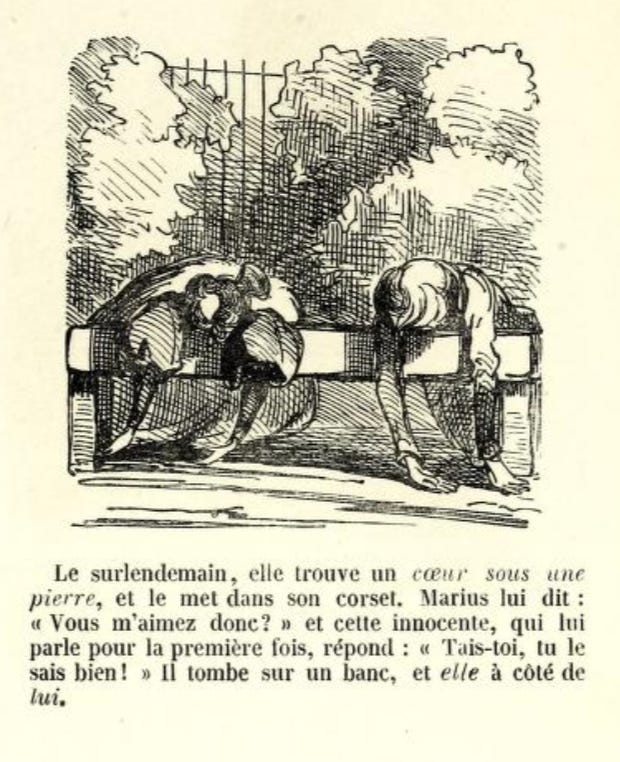
The earliest filmed adaption I’ve seen is Victor Hugo et les principaux personnages des <<Misérables>>, a minute-long video from 1897 of someone posing as Victor Hugo and then getting changed super quick and posing as a character from the book, over and over again. This one definitely pushes my earlier definition of ‘adaptation’, but it’s on the Wikipedia list of adaptations (and I promise I didn’t put it there myself, despite that being my second-favourite Wikipedia page to edit), so someone out there agrees with me that it should count.
The most recently released on the list is the Blox End Les Misérables Proshot (2024), which is an hour of Robloxians performing an abridged version of the musical. I started watching it just for the bit and then got super into it and watched the whole thing.
Run-time data
In my quest to save time by not rereading the 1300-page book, I watched/listened to a total of 8259 minutes (137.65 hours) of adaptations. The real number is higher because I have of course rewatched many of them over and over and over again, but that’s the number I get from adding all the run-times together.
The average run-time of an adaptation is 187.7 minutes (3.1 hours).
The longest is Shōjo Cosette, a 2007 anime series totalling 1248 minutes (20.8 hours). I watched this in May/June and therefore every single one of those 20 hours were hours that I should have spent revising. By a total coincidence, I also managed to watch the episode set on 5th June 1832, titled 5th June 1832, on 5th June 2024; and my Bereal went off whilst I was on the title page. I however did not realise it had been the 5th June until the next day.
The shortest is the previously mentioned Victor Hugo et les principaux personnages des <<Misérables>>, being only a minute long. This is followed by Albert Capellani’s Le Chemineau (1905), at five minutes long (although the ending is lost).
Part 2: the listicles!!
2a. “Claire, it’s French!” — the best bobs of Les Mis
For some reason, Les Mis adaptations are a breeding ground for bobs.
In third place: the entire 2011 Los Miserables musical production in Madrid. This is one of my favourite productions of the musical for several reasons: Daniel Diges as Enjolras achieves the perfect combination of sternness and youthful excitableness (his little giggle in ‘Red and Black’ is constantly on repeat in my head); Grantaire takes a little drink from a candle at one point; and Fantine is heartbreakingly hopeful in ‘I Dreamed a Dream’. But the best part is that literally everyone has a bob.
In second place: John Malkovich as Javert in the 2000 miniseries (dir. Dayan). John Malkovich is my second favourite Javert (after Anthony Perkins in the 1978 telefilm). Sadly they get rid of his extremely luscious bob later in the series to show his aging, but the wavy bob and leather jacket combo is probably the high point of the first part. The costume and hair feels extremely out-of-character for book Javert, but this isn’t book Javert, it’s John Malkovich Javert, and it is extremely in-character for John Malkovich Javert.
In first place: Gillenormand’s bob with micro-bangs in the otherwise forgettable 1912 silent film. I watched this film literally a few hours ago and have already forgotten everything else about it other than this haircut.
2b. “To the barricades!”
Which actors performed this line the best and the worst?
The winner is Brian Blessed as Jean Valjean in the 2001 radio drama produced by Arnold (not to be confused with the far superior 2001 BBC radio drama). I felt his voice was severely under-utilised in general in this adaptation, but “to the barriCADES!” redeemed him somewhat.
The loser is every adaptation where Marius says it, especially the 1998 film (dir. August). Why would Marius say it? Marius should be off feeling sorry for himself.
2c. The least cool Mariuses (Marii?)
Speaking of Marius being off feeling sorry for himself, I strongly belief that Marius should not be as pathetic as possible, so these are my top 5 least cool (and therefore the best) Mariuses. I fear that inclusion on this list might seem like an insult, but I promise with all my heart that it is not, and is in fact a very high honour because it means I think you’ve adequately picked up on how hilarious Marius can be as a character. (And it means you didn’t replace Enjolras with Marius.)
In sixth place: I Miserabili (1964). Everyone kinda thinks he’s a cop, which happens in a few adaptations and is something I always find entertaining.
In fifth place: Marcia Williams’ 2014 picture book. He has fan art of Cosette on his bedroom wall.
In fourth place: the current 2nd cover Marius on the West End, Ben Oatley. I’m so obsessed with his performance, and I apologise for the intensity of my infodumping to him at stage-door afterwards, and thank him for being very kind and signing my copy of the book. In ‘The Robbery / Javert’s Intervention’, he put his hand up when Javert asked ‘Was there a witness to this?’ and I thought it was the funniest part of the entire show.
In third place: Nick Jonas in the 25th Anniversary Concert. A controversial 3rd favourite Marius, but every time someone jokes about him seeming out-of-place as a pop star amongst a cast of musical theatre actors, I can’t help but feel like someone somewhere casting this production knew deep down that Marius should seem kind of awkwardly out-of-place. Either way, I think it just really works.
In second place: the 1978 telefilm (dir. Jordan). Marius spends half of this film just staring kind of creepily.
In first place: Cham’s 1862-3 parody comic in Le Journal Amusant (translated by Psalm22-6 on Tumblr). I will let my two favourite jokes from this comic speak for themselves:

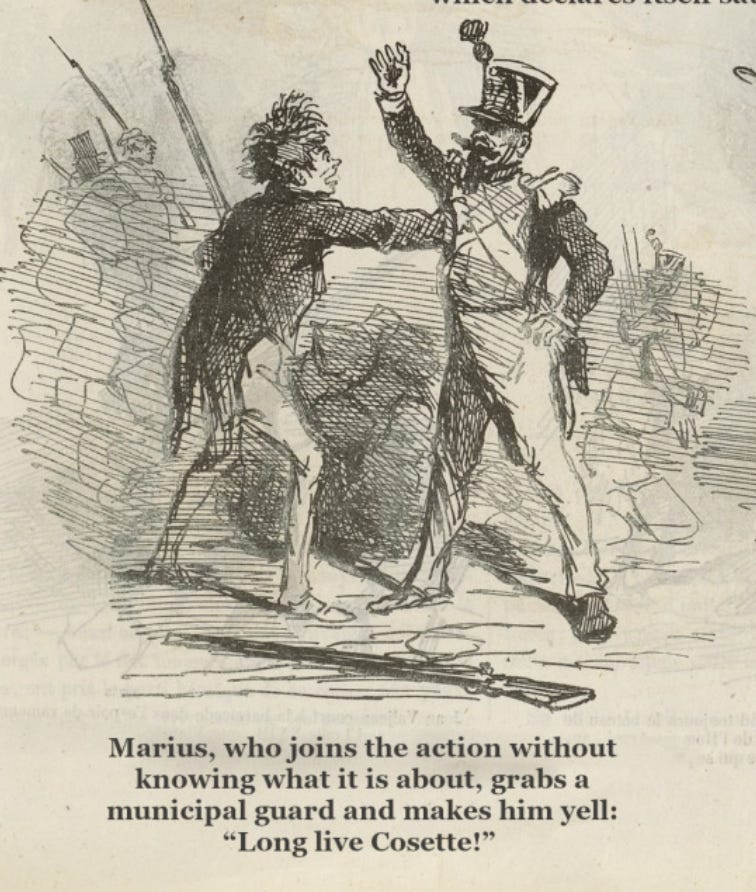
Part 3: my top 10!!
Spoilers for adaptations (beyond the plot of Hugo’s book, which is obviously fair game) are in italics if you want to skim over them.
Not necessarily the top 10 best, but the top 10 most interesting, noteworthy, etc
10: 2001 BBC radio drama, produced by Mortimer
Run-time: 343 minutes, divided into 5 episodes.
Language: English
Where to listen: Internet Archive
When I listened to it: 8th May 2024
Thoughts: this one gets a lot of its points from how adorable Valjean and Cosette are. Just watch this animatic.
9: 2014 picture-book by Marcia Williams
Language: English
Where to read: you can buy a copy, which I would recommend because it is a beautiful book, or it’s on the Internet Archive.
When I read it: 12th-14th July 2024
Thoughts: Les Mis but everyone has a cat! This is another adaptation that gets quite a bit of credit for how cosy it is. I’m also always really interested in how people adapt such an intense story for children, so there are a couple of children’s adaptations on this list.
8: Les Misérables - Owarinaki Tabiji (The Endless Story), (2019, dir. Namiki)
Genre: telefilm, loose adaptation
Run-time: 144 minutes
Language: Japanese
When I watched it: 20th June 2024
Thoughts: Set in modern Japan, this film seems very aware of its status as a loose adaptation, and uses that relationship with the source material (and with other adaptations) to its advantage.
It ends with the Javert-ish character arresting the Valjean-ish character7, but because you’re (probably) watching with the knowledge that book-Valjean gets free again, the ending becomes more ambiguous than it is in the film itself because of its relationship to the source text. Its status as an adaptation doesn’t make it subservient to the source material, but rather gives it a piece of writing to play with and to use the audience’s existing knowledge of to create possibilities of meaning.
A great bit of inter-adaptation-intertextuality I loved was when the Valjean-ish character agrees to the Marius-ish character and the Cosette-ish character having a relationship, and the melody of ‘Do You Hear the People Sing’ is incorporated into the score. I always always love when adaptations reference other adaptations; there is (as I hope this blog post demonstrates) a long lineage of Les Mis adaptations to draw from and interact with, so it was brilliant to see this film use the recognisability of that melody to add certain emotional connotations to the scene.
7: Gavrosh (Гаврош) (1986, dir. Hurvych)
Genre: animated short
Run-time: 17 minutes
Language: no dialogue, but it’s a Ukrainian production
Where to watch: It used to be on Youtube
When I watched it: I can’t remember
Thoughts: I have far less to say about this one because it’s fascinating in ways I really do not have the skillset/knowledge-base to articulate. I think it’s an extremely visually appealing and creative use of its medium as an animation (I don’t know anything about animation, but everyone moves in interesting ways). This is one of several Soviet-era short film adaptations, most of which revolve around the character of Gavroche, so I would love to read some analyses of that trend from anyone who’s more of an expert in Soviet cinema/culture than I am.
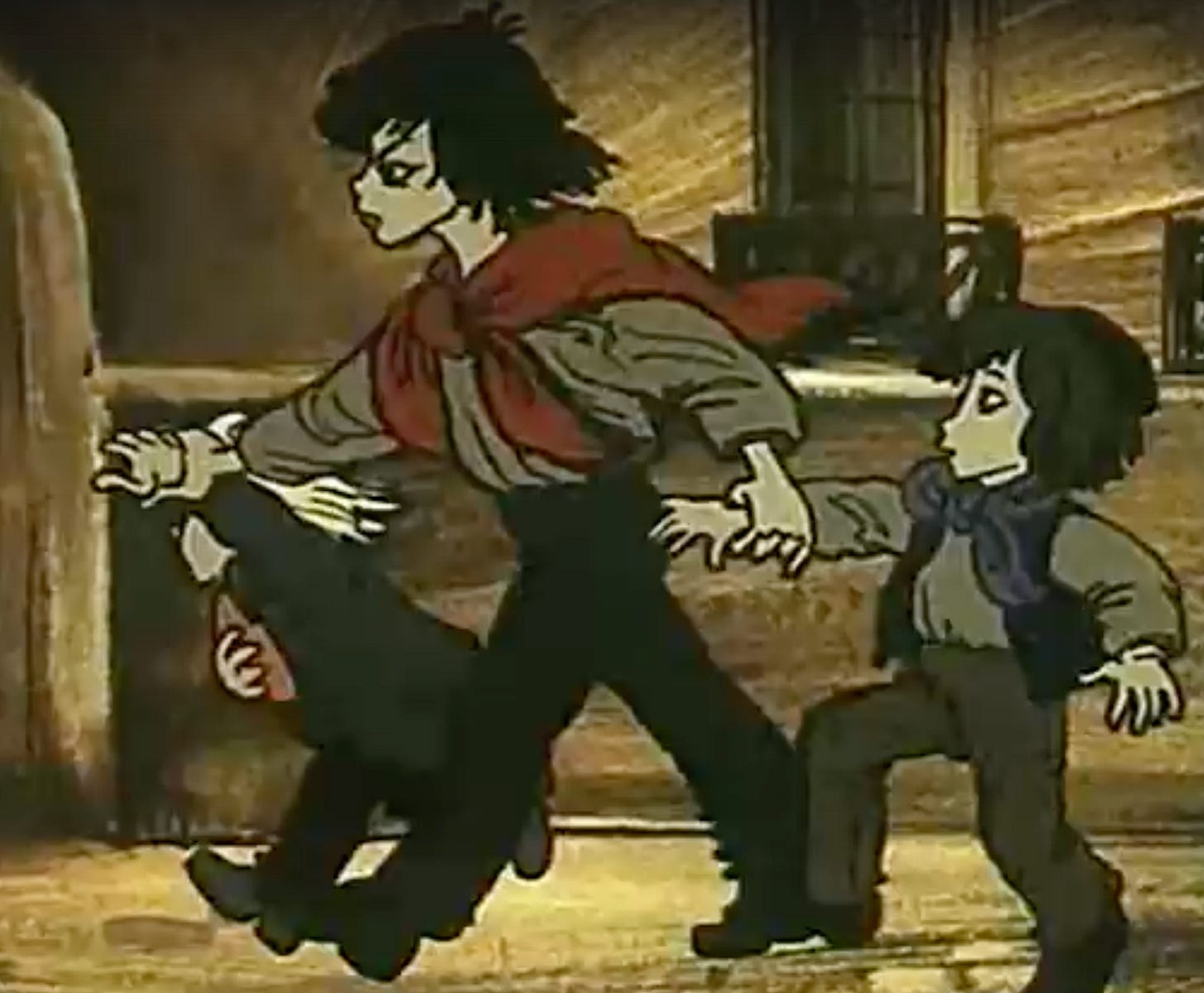
6: 1925, dir. Fescourt
Genre: silent film
Run-time: 359 minutes (divided into four parts)
Language: French (there’s no dialogue, but there are French intertitles)
Where to watch: Internet Archive (I did email Pathé to ask if they would ever release the 2014 restoration of it on DVD, but sadly they did not respond)
When I watched it: 15th-18th July 2024
Thoughts: This film maybe shouldn’t be this high up on the list, especially because the second half is significantly worse than the first half (they ran out of money half-way through production and you can tell), but it has a special place in my heart because of the amount of nights I spent working on the Wikipedia page8 for it, getting so absorbed that I would barely look away until the sun started coming up and I realised it was 4am and I’d been researching it for 12 hours straight. Shoutout to the Discord group chat with Psalm and Francis, who went on that journey with me and found countless sources about this film’s truly fascinating production and distribution (also shoutout to everyone who has listened to me infodump to them about this). I will definitely write a post soon about some anecdotes from the production of this film that weren’t relevant enough to make it into the Wikipedia page. You can also read Psalm’s post about its distribution.
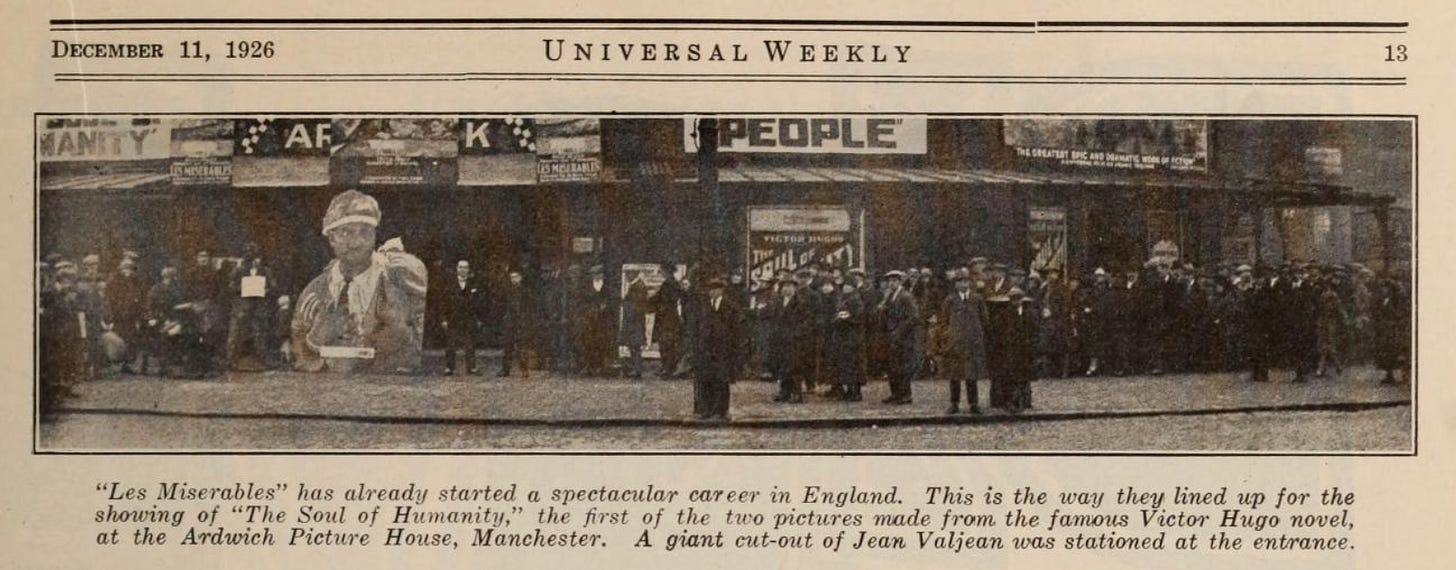
I do also have thoughts about the actual film. This was the first long silent film I’d ever watched, and it totally shattered every preconception I had about what it was actually like to watch a silent film. This had been on my watch-list for ages before I got to it, because I assumed 6 hours with no dialogue would be mega tedious. I’d imagined silent films as basically just like modern films, but minus the talking. This seems like a logical assumption, but in actuality the lack of speech is more than compensated for with other techniques that are really uncommon to see in films today because of our expectation of naturalism (something that Pureanon pointed out in their Barricades Con panel about obscure adaptations, and I failed to fully appreciate until going and watching this film for myself).
There’s a genius parallel between Valjean’s stays at the Bishop’s and at the Thénardiers’. Both are in sequences that use the green filter, have Valjean get up in the night, hold an object over another character, then give/take some valuable metal. At the Bishop’s, he holds a knife over Monseigneur Bienvenu; at the Thénardiers’, he holds a candle over Cosette. At the Bishop’s, he takes the silver; at the Thénardiers’, he leaves Cosette a coin for Christmas.
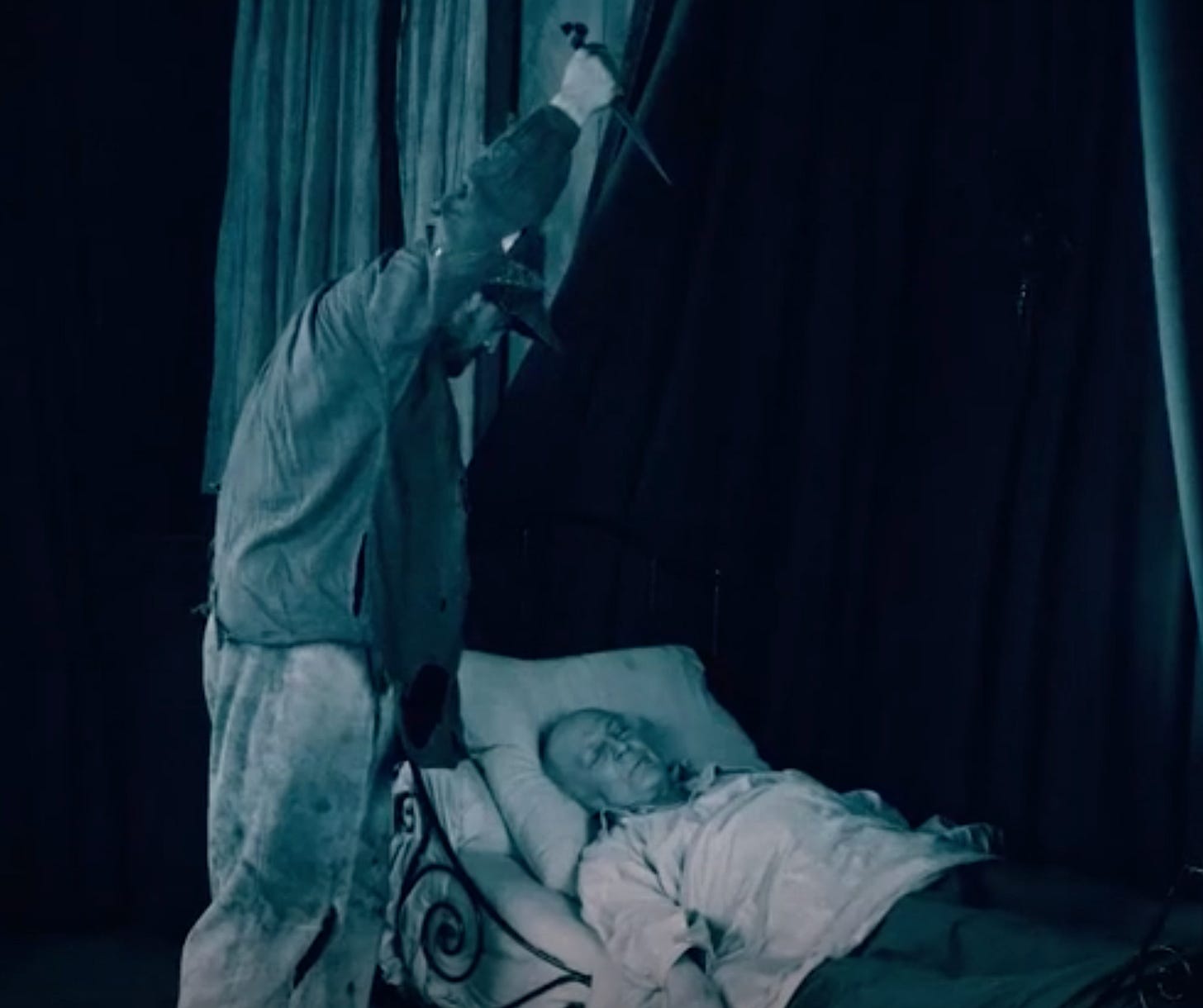
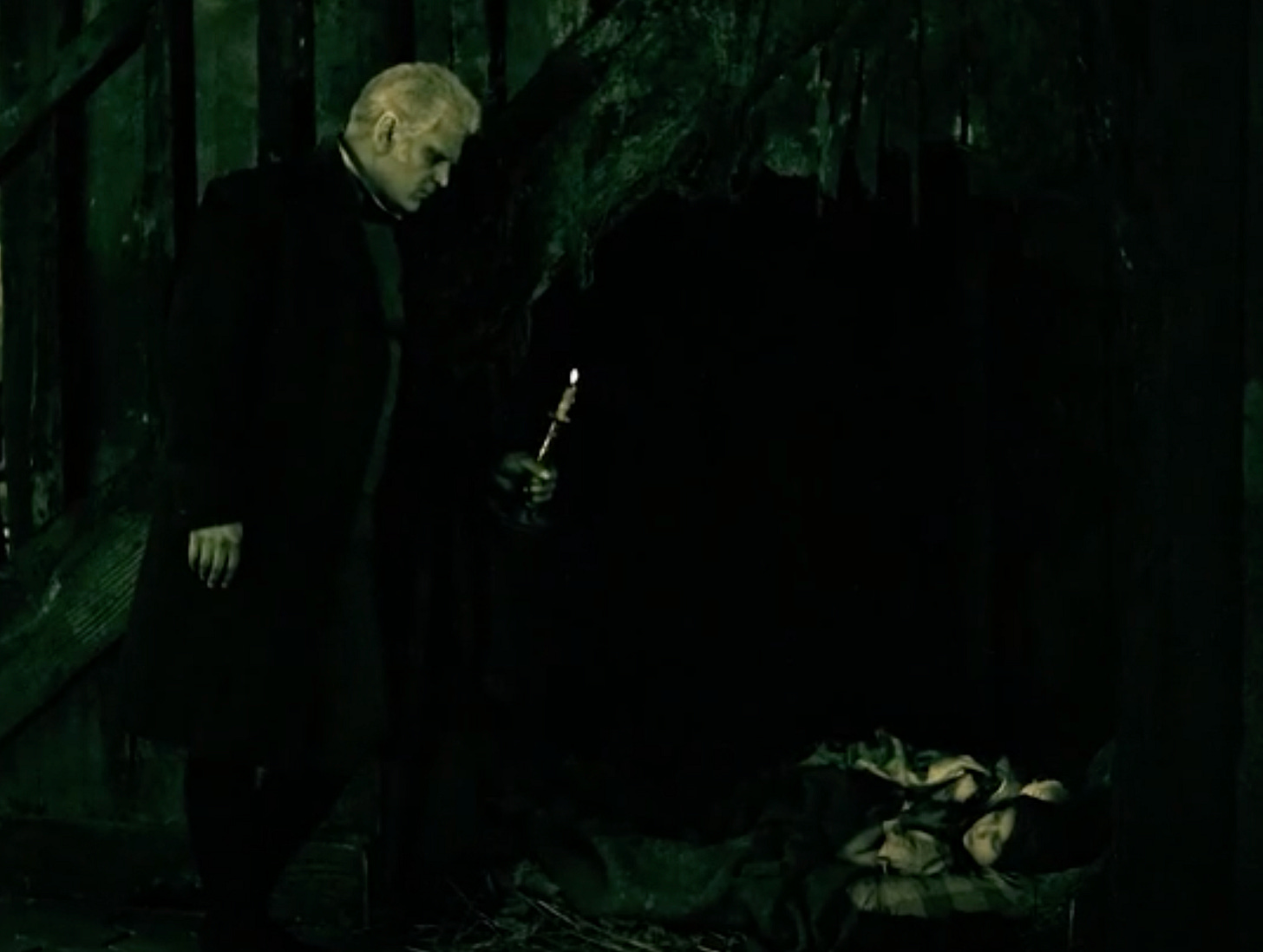
Silent films were also not really silent! They were usually accompanied by live music, and the audio you hear in this is music played at a screening of the recently restored film at the Festival d'Anères in 2016. Because the score is so much more recent than the film, it allows for yet more of my favourite thing: inter-adaptation-intertextuality! When Gavroche dies, the melody of ‘La Faute à Voltaire’ (‘Little People’) plays in the score.
Also, Valjean and Fauchelevent are absolutely adorable together in this adaptation. They look like they’re about to kiss in every single scene they share.
5: 2019, dir. Ly
Genre: live-action film, loose adaptation
Run-time: 104 minutes
Language: French
When I watched it: 21st June 2024
Thoughts: This loose adaptation, set in modern Montfermeil, is the greatest illustration on this list of Linda Hutcheon’s statement that after watching a film adaptation of a book, “I suspect I will never be able to recapture my first imagined versions again. Palimpsests make for permanent change.”9 After police shoot and injure Issa, a young Black boy, the lyrics of the ‘c’est la faute à Voltaire’ song that Gavroche sings before dying are incorporated into dialogue between Issa and Chris, a white policeman trying to cover up their brutality. For Gavroche, the line ‘Je suis tombé par terre’ (‘I fell to the earth’) is playful and a demonstration of his childishness and agency until his death; but for Issa, that same line is subverted into a declaration that denies him the freedom to be childish and the agency to speak freely about the violence committed against him.
4: 1972, dir. Bluwal
Genre: mini-series
Run-time: 245 minutes (divided into two episodes)
Language: French
When I watched it: 19th-20th April 2024
Thoughts: 1972 has my all-time favourite Enjolras, Jean-Luc Boutté, and its focus on Les Amis is what places it so highly in my own and the entire fandom’s rankings. Courfeyrac’s delivery of ‘être libre’ is particularly perfect. Bluwal has absolutely no qualms about skipping over pretty major chunks of the book he seems to think are boring, so it probably isn’t the best if you’re not already familiar with the plot, but this means it avoids the common pitfalls of feeling like it’s rushing to tick every plot-point box, or just recounting the plot without adding much.
3: I Miserabili, 1964, dir. Bolchi
Genre: mini-series
Run-time: 613 minutes (divided into ten episodes)
Language: Italian
Where to watch: Raiplay; and lucrezianoin wrote some translated English subtitles
When I watched it: 8th-16th June 2024
Thoughts: This is an extremely monologue-heavy series, my favourite monologue being the adaptation of Enjolras’ ‘the nineteenth century is great, but the twentieth century will be happy’ speech, which comes after Grantaire breaks down about Enjolras killing Le Cabuc, in a way that reveals the kind of admiration and idealisation Grantaire has for Enjolras that Hugo writes about in 3.4.1. The execution of Le Cabuc seems to damage the image of Enjolras that Grantaire has; not so much in a way that lowers Enjolras’ standing in Grantaire’s eyes, but in a way that forces Grantaire to confront the reality of what they’re doing. Claudio Sora plays another of my favourite Enjolrases, and episode 9, which this monologue comes from, is a masterpiece.
At the same time, I Miserabili can be one of the funnier adaptations. The cab scene (where Lesgle and Marius meet) in the ‘Children of Waterloo’ episode (half an episode dedicated to Waterloo is also a big plus for digression fans) is yet another masterpiece, but this time a comedic one. This adaptation also has the best Lesgle.
2: Christina Soontornvat, A Wish in the Dark (2020)
Genre: middle-grade fantasy book, loose adaptation
Page count: 375
Language: English
Where to read: options on Christiana Soontornvat’s website
When I read it: 20th-23rd August 2024
Thoughts: I wrote an entire blog post of thoughts about this one!
1: The West End production
When I watched it: 29th June 2024 (evening performance)
Thoughts: I’ve only seen Les Mis live once, and it was obviously going to make the top of the list.
Tom Hext’s performance as Grantaire was actually life-changing. He was always trying to follow Enjolras (Djavan van de Fliert) round the stage, and looked lost and alienated whenever he wasn’t either with Enjolras or looking after Gavroche. Grantaire was laughed at when he started his ‘Drink with me’ verse. Before the final battle, he and Enjolras hugged and pressed their heads together. He was the last alive at the barricade, and when he realised this, he ran up the barricade into the bullets in the same spot Enjolras died.
And I made friends seeing it live!
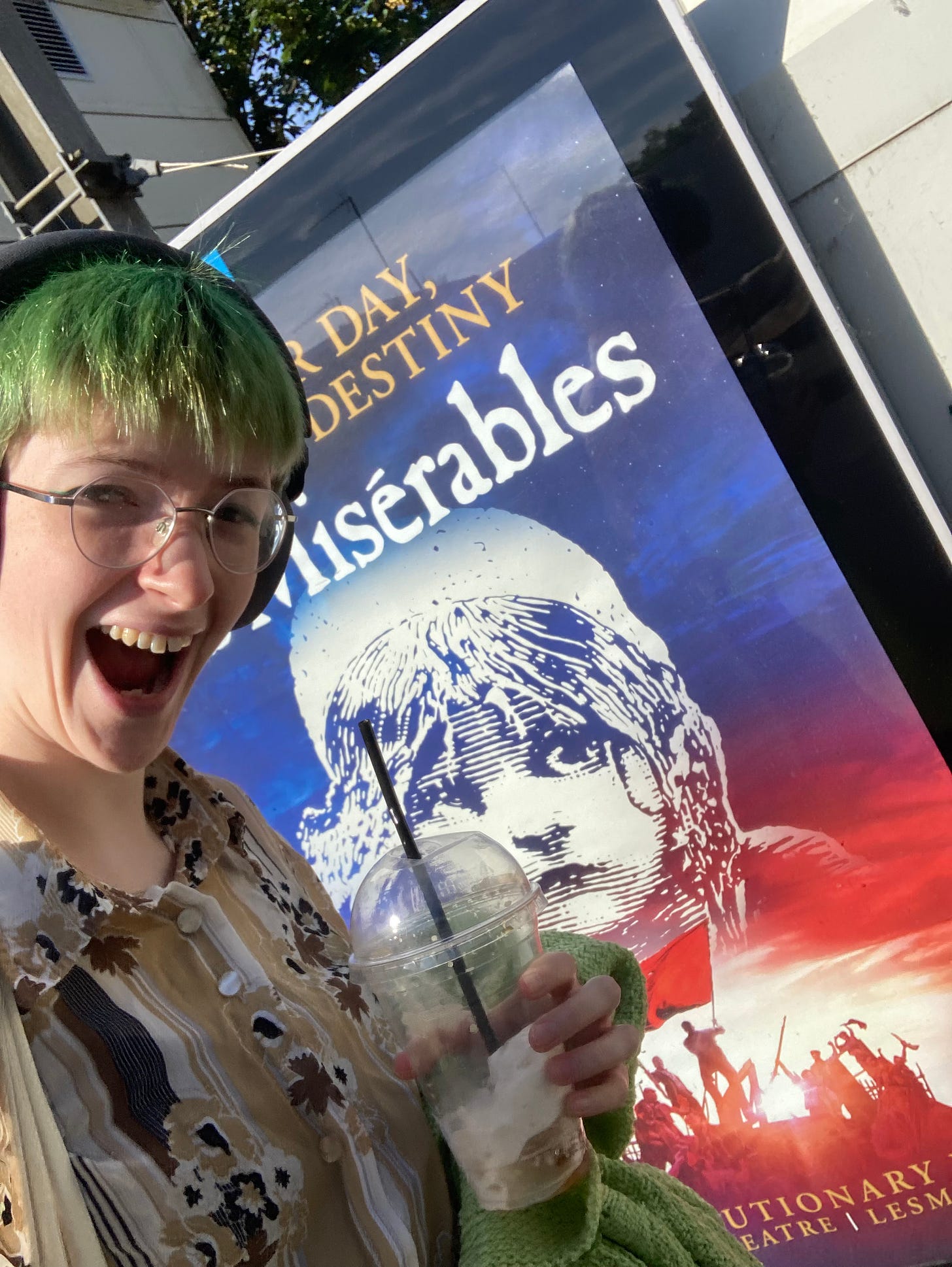
I’m limiting myself to only one version of the musical in this list because it’s sort of a category of its own. But for the sake of the other musical productions that I love dearly, here is a listicle within a listicle of my other favourites:
2011 Madrid, which I spoke about in the bobs listicle
1992 Amsterdam, which has one of the best Fantines
2012 movie musical, which certainly has some major downfalls pointed out by many people (cough, cough, Grantaire’s ‘Drink with me’ verse; also Marius is too cool), but which I maintain is the most rewatchable of all these adaptations.
Part 4: honourable mentions, a bingo card, my future watch-list
There are a few moments/tidbits from my 50 adaptations that this post would feel incomplete without sharing, but which haven’t fit into any other categories, so here are some honourable mentions:
In the 1997 Chelmsford open air concert, the ‘call them to arms’ lyric in ‘Red and Black’ is changed to ‘fire their blood’, which I haven’t heard anywhere else (which doesn’t surprise me, because it is rather an intense line).
Basically everything about 1948 I Miserabili (dir. Fredda). Many people have pointed out the excessive number of explosions and the fact that Grantaire is aged up by about five decades. Also, I wrote in my notes when I watched it that Valjean dies after being shot by Thénardier and then Thénardier falls to his death. But the whole film was so weird that it’s one blurred mess in my mind and I can’t even remember that happening.
I thought Enjolras and Grantaire were actually going to survive in Shōjo Cosette, and then was really sad when they didn’t.
I’ve also been compiling a drinking game / bingo card type thing of weird and/or iconic things that pop up in several adaptations, which you can play along with whilst watching adaptations yourself. I’m just laying it out as a list, and you can add your own drinking game rules, or make it into a grid (there’s actually not enough to make it into a 3x3 grid but you can add your own… this is a wip), or whatever:
“To the barricade!”
Cosette has a gun
Heaven is prison/the barricade/revolution/etc, but super chill
Grantaire is an old man
Jean Valjean calls someone “boy!”
Marius is a revolutionary leader
Suspicious Valjean/Javert staring close-ups (this happens constantly, so use this one to drink some water or something)
Finally, some adaptations I’m looking forward to getting to soon!
I have tickets for the new Paris production in December and the Arena Tour in January!
I’m massively looking forward to English subtitles being added to Luciano Muriel’s Grantaire musical monologue in the near future.
You can’t currently watch the 1917 Frank Lloyd film adaptation (see Psalm’s post for details about that), but I can’t wait to read the (partial) screenplay of it.
In the process of making this, I came across a 6-minute long animation from 1986 called Les Miserobots, which appears to be some sort of Les Mis thing involving robots, with some connection to Pink Panther (I know nothing about Pink Panther). I would’ve watched it immediately, but then my total would’ve been 51, which isn’t as nice of a number as 50.
Also in the process of making this, someone told me about a Sesame Street special called ‘Les Mousserables’.
In the process of searching for a link for the Sesame Street video, I also found an episode from the children’s TV series Anatole called ‘Les Mouserables’. Maybe I’ll have to write a listicle of children’s TV adaptations with puns in their titles.
I desperately want to go to the annual sound and lights show in Montreuil, but I’ve got no idea when that’ll be practical. Maybe next year…
By this definition, the Symphonic Recording could count, but I didn’t count it.
I know people don’t like using the word “consumed” to talk about art, but it’s quicker than saying watched/read/listened to, so I’m using it.
1978, dir. Jordan; 2019, dir. Namiki
1912, dir. Capellani; 1925, dir. Fescourt
1925, dir. Fescourt; 1934, dir. Bernard
I wrote a bit about the limitations of this approach to loose adaptations in my Wish in the Dark review, but for the sake of this very short review, it’ll have to do.
I know there isn’t a plot summary. I might get round to it one day, but really I don’t believe that every single Les Mis adaptation needs its own plot summary on its Wikipedia page. It’s literally Les Mis.
Linda Hutcheon, A Theory of Adaptation, 2nd edn., (Routledge: 2013), p. 29.



















